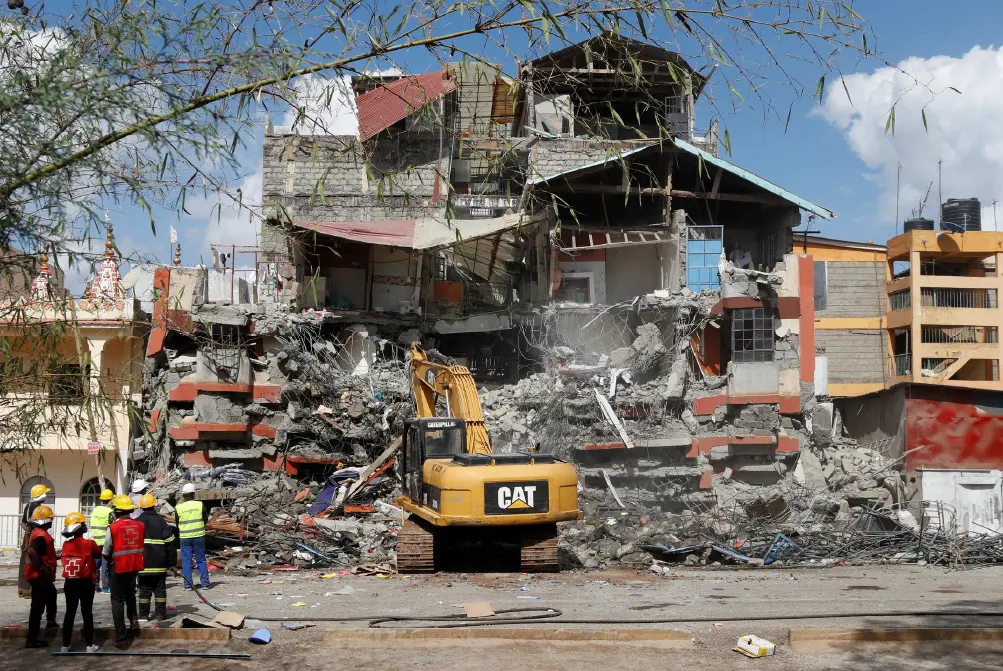As often happens, the collapse of a building in Kasarani was just another trending story, until reports of yet another collapsed building in Ruaka flooded the news cycle and the Kenyan Twittersphere on a rainy Thursday morning. Was it a streak of bad luck, that the gods of construction were angry with us for some reason, or was it human negligence?
A light drizzle was still falling as I made my way to the location described on Twitter, where I arrived to a somber welcome party of police pickups, an ambulance and a milling crowd of onlookers. The collapsed pile of concrete was visible from two or three rows behind the armed police who kept the crowd back. I stayed well behind the police barrier. That was good enough.
More and more people came by, asking if anyone had been hurt. Then two or three policemen came through, demanding the crowd make way. “Hapa kuna njia kweli?” As rescue workers walked around the collapsed structure, a bystander observed that the heavy slabs could not be lifted immediately. “Hii inatake bulldozer. Yenye inainua na inachota,” she said. As the rain fell, some in the crowd grumbled about the Kiambu County government. “Acio meĩtaga kanju maheagwo kanyamu kanini magathiĩ.” Those people who call themselves the County get something small and go.
“Si hiyo mchanga ni weak?” said one.
“Labda wale walikoroga walikuwa walevi,” guessed another.
The police parked a pickup in reverse, with the rear facing the collapsed building, and people murmured in the drizzle, fearing and hoping. News filtered through the crowd that an elderly couple lived in the house that had been crushed. “Ĩguĩrĩire nyumba ya murata wa mathe. Nĩĩkomereirwo” It has fallen on the house of my mum’s friend. It’s on top of the house, one person said. And another, “Nyumba ya cucu na mzee imeagukiwa”.
A woman in the crowd said she had been their tenant.They were good people, she said. Two women huddled near the gate and I guessed they were close friends of the family. An elderly woman pushed her way to the front. As time passed, it became clear that this elderly couple was at the heart of a little community that cherished them. Communities that our concrete jungles are wiping out, with many elderly people who live dignified lives in humble homes that could never survive being crushed by six storeys of concrete.
Then, what everyone feared happened very quickly.
A group of rescue workers, walking fast and carrying a body bag, heaved it quickly onto the police pickup. I will not soon forget the heartbreaking wails of the women at the gate. Kiu nikio kimarokeire, Mwathani? Is this what met them this morning, O Lord!?
The Ruaka and Kasarani collapses brought to the fore how little has changed in Kenya over the years, from the Kihonge building in 2006 to the Huruma collapse in 2016 and now these. What don’t we in Kenya know about collapsing buildings?
Counties not doing enough inspections? We know that. Corrupt inspectors? We know that. Substandard materials? Yes. Poorly mixed concrete? Correct. Unqualified fundis? Yes. Exceeding approved floors? Sure. Building on riparian land? Kabisa. Continued construction of a condemned building? We know. We know everything.
Our urban development rules are plagued by a major inconsistency; we ignore what we know to be true. So we assume the best of human nature in a rabidly corrupt industry and country. We prosecute builders of unsafe buildings when the illegalities are too painful, fatal and final to ignore.
When a county government condemns a building and marks it with a huge X in red paint, what prevents a developer from ‘uncondemning’ it by painting over the red markings? Now that we know some developers don’t stop building despite orders to do so, why not just demolish condemned buildings? They’ll come down at some point. Why not arrest officials who receive bribes, whether or not a building collapses?
We must also make a radical change towards transparency.
Why not issue a press release as soon as a building is condemned, instead of after the collapse as we saw government officials do? Why do we leave space for corruption?
Every condemned building should be listed on the websites of the National Construction Authority (NCA) and the respective county, alongside its photograph and coordinates. Now, the NCA does in fact list some “Suspended Sites” on its web page. For example the most recent list for Kiambu Region dated 3 June 2022, includes a different building in Ruaka from the one that collapsed, and perhaps an updated list would have contained the just collapsed building. However, a more complete solution might include posting inspection reports and current statuses for every building site online, in a geographic information system the public can readily access.
Do we have enough inspectors and engineers?
Counties should tell Kenyans in annual reports how many inspectors they have, how many inspections they do, and how much it all costs. Are they adequately paid for this life-and-death work that we now know is vital?
Solutions clearly exist, but for Peter Njuthi and Faith Wambui in Ruaka, they’ll come far too late.
Let their deaths be the last.

